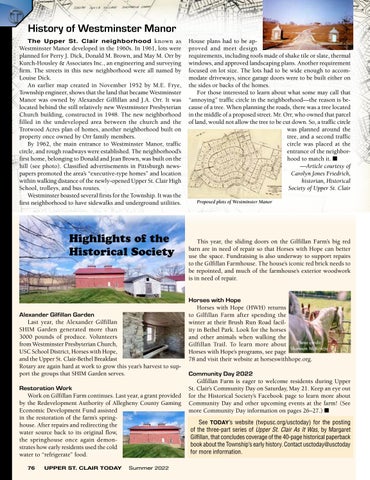History of Westminster Manor The Upper St. Clair neighborhood known as Westminster Manor developed in the 1960s. In 1961, lots were planned for Perry J. Dick, Donald M. Brown, and May M. Orr by Kurch-Housley & Associates Inc., an engineering and surveying firm. The streets in this new neighborhood were all named by Louise Dick. An earlier map created in November 1952 by M.E. Frye, Township engineer, shows that the land that became Westminster Manor was owned by Alexander Gilfillan and J.A. Orr. It was located behind the still relatively new Westminster Presbyterian Church building, constructed in 1948. The new neighborhood filled in the undeveloped area between the church and the Trotwood Acres plan of homes, another neighborhood built on property once owned by Orr family members. By 1962, the main entrance to Westminster Manor, traffic circle, and rough roadways were established. The neighborhood’s first home, belonging to Donald and Jean Brown, was built on the hill (see photo). Classified advertisements in Pittsburgh newspapers promoted the area’s “executive-type homes” and location within walking distance of the newly-opened Upper St. Clair High School, trolleys, and bus routes. Westminster boasted several firsts for the Township. It was the first neighborhood to have sidewalks and underground utilities.
Highlights of the Historical Society
Alexander Gilfillan Garden Last year, the Alexander Gilfillan SHIM Garden generated more than 3000 pounds of produce. Volunteers from Westminster Presbyterian Church, USC School District, Horses with Hope, and the Upper St. Clair-Bethel Breakfast Rotary are again hard at work to grow this year’s harvest to support the groups that SHIM Garden serves. Restoration Work Work on Gilfillan Farm continues. Last year, a grant provided by the Redevelopment Authority of Allegheny County Gaming Economic Development Fund assisted in the restoration of the farm’s springhouse. After repairs and redirecting the water source back to its original flow, the springhouse once again demonstrates how early residents used the cold water to “refrigerate” food. 76
UPPER ST. CLAIR TODAY
Summer 2022
House plans had to be approved and meet design requirements, including roofs made of shake tile or slate, thermal windows, and approved landscaping plans. Another requirement focused on lot size. The lots had to be wide enough to accommodate driveways, since garage doors were to be built either on the sides or backs of the homes. For those interested to learn about what some may call that “annoying” traffic circle in the neighborhood—the reason is because of a tree. When planning the roads, there was a tree located in the middle of a proposed street. Mr. Orr, who owned that parcel of land, would not allow the tree to be cut down. So, a traffic circle was planned around the tree, and a second traffic circle was placed at the entrance of the neighborhood to match it. n —Article courtesy of Carolyn Jones Friedrich, historian, Historical Society of Upper St. Clair Proposed plots of Westminster Manor
This year, the sliding doors on the Gilfillan Farm’s big red barn are in need of repair so that Horses with Hope can better use the space. Fundraising is also underway to support repairs to the Gilfillan Farmhouse. The house’s iconic red brick needs to be repointed, and much of the farmhouse’s exterior woodwork is in need of repair. Horses with Hope Horses with Hope (HWH) returns to Gilfillan Farm after spending the winter at their Brush Run Road facility in Bethel Park. Look for the horses and other animals when walking the Photo credit: Gilfillan Trail. To learn more about Shannon McKenzie Horses with Hope’s programs, see page 78 and visit their website at horseswithhope.org. Community Day 2022 Gilfillan Farm is eager to welcome residents during Upper St. Clair’s Community Day on Saturday, May 21. Keep an eye out for the Historical Society’s Facebook page to learn more about Community Day and other upcoming events at the farm! (See more Community Day information on pages 26–27.) n See TODAY’s website (twpusc.org/usctoday) for the posting of the three-part series of Upper St. Clair As It Was, by Margaret Gilfillan, that concludes coverage of the 40-page historical paperback book about the Township’s early history. Contact usctoday@usctoday for more information.

